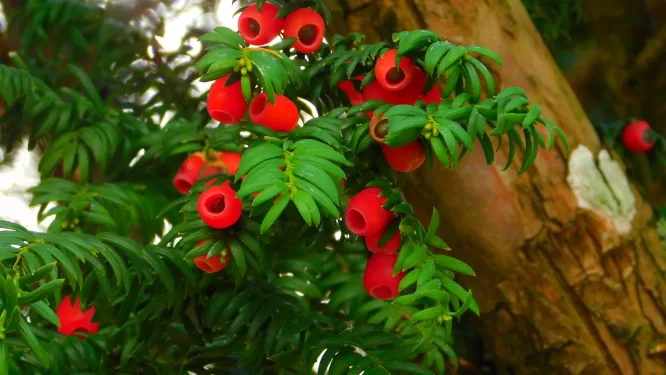Pacific Yew, Tree of the Future at CPTC
A Priceless Cancer Treatment Grows on Campus

By Marcia Wilson
Let us appreciate CPTC’s Taxus brevifolia, the Pacific Yew. The bark is the only source of the world’s most powerful antimicrotubule agent drug, Paclitaxel.
Simply put, it stops cancer cells from growing. Dwarf varieties grow between Buildings 23 and 21, where medical students take their classes and may someday dispense this medication. No other tree, and no other species of yew, possesses the compounds necessary to manufacture this lifesaver.
Yew Trees are unique, but Pacific Yew is the most unique of all.
This may guarantee its survival for the future: yews grow slowly, and we need them healthy; the bark harvests are a global, multi-million-dollar industry. 2021 saw almost $9,000,000 USD in medicinal sales for the use of cancer treatments (the year before saw almost 2 billion dollars!).
Wint er is a good time to appreciate their beauty: the trees do not have berries, but arils. That soft red flesh you see in the photo is part of the seed itself. You’ve already eaten arils if you’ve drunk pomegranate juice. Don’t eat these, please. Birds and a few mammals will swallow the soft arils, sensibly avoiding the poisonous nut inside, for all parts of the Yew are highly toxic. Its ability to kill from accidental ingestion is one of the reasons why it is called the Tree of Death.
er is a good time to appreciate their beauty: the trees do not have berries, but arils. That soft red flesh you see in the photo is part of the seed itself. You’ve already eaten arils if you’ve drunk pomegranate juice. Don’t eat these, please. Birds and a few mammals will swallow the soft arils, sensibly avoiding the poisonous nut inside, for all parts of the Yew are highly toxic. Its ability to kill from accidental ingestion is one of the reasons why it is called the Tree of Death.
Yews have been planted in graveyards for thousands of years as a Tree of Life; they live a very long time with the record held by the Llangernyw Yew in Cymry, estimated at 4,000-5,000 years old (that’s the Bronze Age, folks. Before we used iron). Additionally, the wood made the valuable longwood bow. (Fun fact: go back far enough in English Lit and you’ll see the word ‘yew’ used instead of ‘bow’. Our yews live to 400 years, which is still a respectable age!
A Rainforest Essential
In the Outdoor Lab, the wild yews are the opposite of the campus collection: mature, majestic, and twisted with dark, rich red leopard-bark mottling when it rains. It is indisputably a ‘Tree of Life’ for animals needing shelter. It also hosts a wide variety of forest flora necessary for a healthy PNW ecosystem. A yew tree makes a good home; Dr. Faust’s trail cameras caught a Great Horned Owl with its juvenile perched on one of our yews earlier this year.
Leaving Yew with this Puzzle to Solve…
CPTC’s forest trees appear to be male, and wind-pollinating the beautiful female yews at the Mt. View Cemetery across the street. Or are they? In rare cases where the T. brevifolia flips gender, and we don’t know how or why. This tree has given us a future when it helped crack an amazing mystery with cancer treatments, but still keeps plenty of its own secrets.